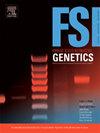Assessing transcriptomic signatures of aging: Testing an mRNA marker panel for forensic age estimation of blood samples
IF 3.1
2区 医学
Q2 GENETICS & HEREDITY
引用次数: 0
Abstract
Estimating the age of an unknown perpetrator can be a valuable tool in narrowing down a group of suspects. Research efforts to estimate the age of a stain donor have mainly focused on epigenetic modifications, but there is evidence that RNA expression patterns, i.e. the composition of the transcriptome, change with increasing age, which could be a promising molecular alternative for age prediction. In a previous study, we identified a total of 508 mRNA markers with age related expression from two blood whole transcriptome sequencing data sets, using differential expression analysis with DESeq2 and marker selection with lasso regression. For this study, the selected markers from both approaches were combined into an RNA-specific targeted MPS assay for the Ion Torrent platform and evaluated with 100 EDTA blood samples from healthy donors (aged between 23 and 73 years). We compared three different normalization methods for the obtained sequencing data and investigated the performance of various regression techniques for age prediction. The model based on elastic net regression and dSVA-normalized data exhibited the most robust performance, achieving an MAE of 9.29 years and a correlation of 0.57 between the chronological and predicted age. Although the use of a targeted approach instead of RNA-Seq offers several advantages in a forensic setting, we observed a considerable amount of unwanted variation in the targeted sequencing data. We conclude that it is challenging to detect distinct signals associated with chronological age.
评估衰老的转录组特征:测试mRNA标记面板用于血液样本的法医年龄估计
估计未知犯罪者的年龄是缩小嫌疑人范围的一个有价值的工具。估计染色供体年龄的研究工作主要集中在表观遗传修饰上,但有证据表明,RNA表达模式,即转录组的组成,随着年龄的增长而变化,这可能是一种有前途的年龄预测分子替代方案。在之前的一项研究中,我们利用DESeq2的差异表达分析和lasso回归的标记选择,从两个血液全转录组测序数据集中共鉴定出508个与年龄相关的mRNA标记。在这项研究中,从两种方法中选择的标记物被结合到离子激流平台的rna特异性靶向MPS分析中,并使用来自健康供者(年龄在23至73岁之间)的100份EDTA血液样本进行评估。我们比较了三种不同的归一化方法对获得的测序数据,并研究了各种回归技术的性能年龄预测。基于弹性网络回归和dsva归一化数据的模型表现出最稳健的性能,MAE为9.29年,实足年龄与预测年龄的相关系数为0.57。虽然使用靶向方法代替RNA-Seq在法医环境中提供了几个优势,但我们在靶向测序数据中观察到相当数量的不需要的变异。我们的结论是,检测与实足年龄相关的不同信号是具有挑战性的。
本文章由计算机程序翻译,如有差异,请以英文原文为准。
求助全文
约1分钟内获得全文
求助全文
来源期刊
CiteScore
7.50
自引率
32.30%
发文量
132
审稿时长
11.3 weeks
期刊介绍:
Forensic Science International: Genetics is the premier journal in the field of Forensic Genetics. This branch of Forensic Science can be defined as the application of genetics to human and non-human material (in the sense of a science with the purpose of studying inherited characteristics for the analysis of inter- and intra-specific variations in populations) for the resolution of legal conflicts.
The scope of the journal includes:
Forensic applications of human polymorphism.
Testing of paternity and other family relationships, immigration cases, typing of biological stains and tissues from criminal casework, identification of human remains by DNA testing methodologies.
Description of human polymorphisms of forensic interest, with special interest in DNA polymorphisms.
Autosomal DNA polymorphisms, mini- and microsatellites (or short tandem repeats, STRs), single nucleotide polymorphisms (SNPs), X and Y chromosome polymorphisms, mtDNA polymorphisms, and any other type of DNA variation with potential forensic applications.
Non-human DNA polymorphisms for crime scene investigation.
Population genetics of human polymorphisms of forensic interest.
Population data, especially from DNA polymorphisms of interest for the solution of forensic problems.
DNA typing methodologies and strategies.
Biostatistical methods in forensic genetics.
Evaluation of DNA evidence in forensic problems (such as paternity or immigration cases, criminal casework, identification), classical and new statistical approaches.
Standards in forensic genetics.
Recommendations of regulatory bodies concerning methods, markers, interpretation or strategies or proposals for procedural or technical standards.
Quality control.
Quality control and quality assurance strategies, proficiency testing for DNA typing methodologies.
Criminal DNA databases.
Technical, legal and statistical issues.
General ethical and legal issues related to forensic genetics.

 求助内容:
求助内容: 应助结果提醒方式:
应助结果提醒方式:


